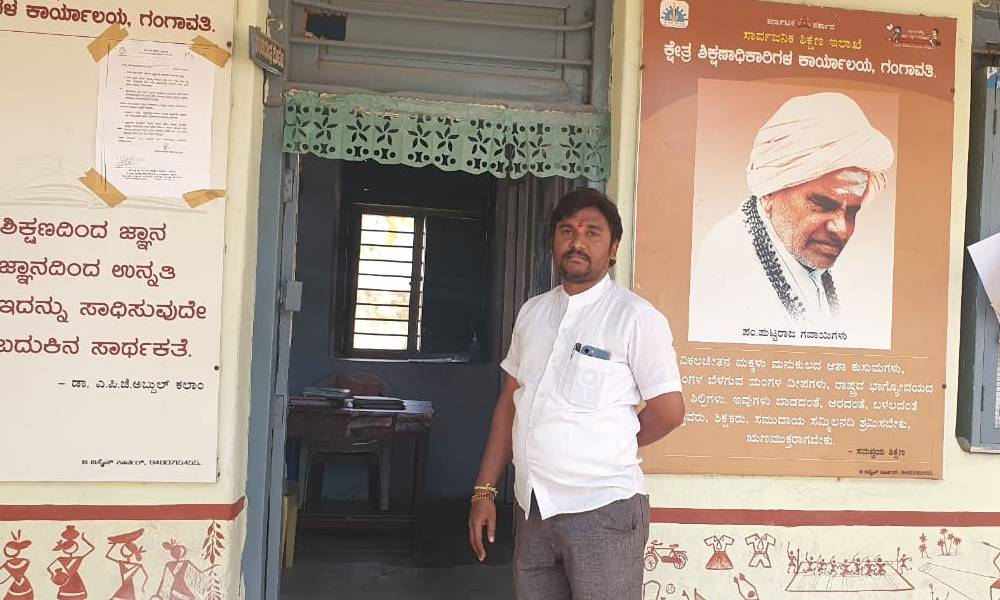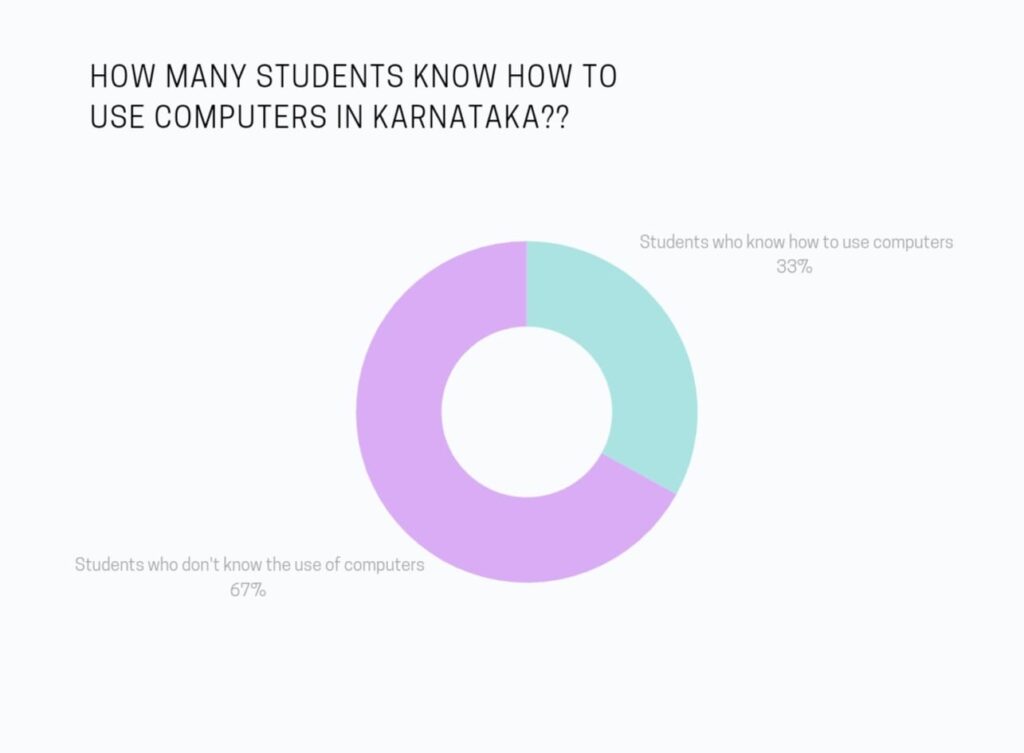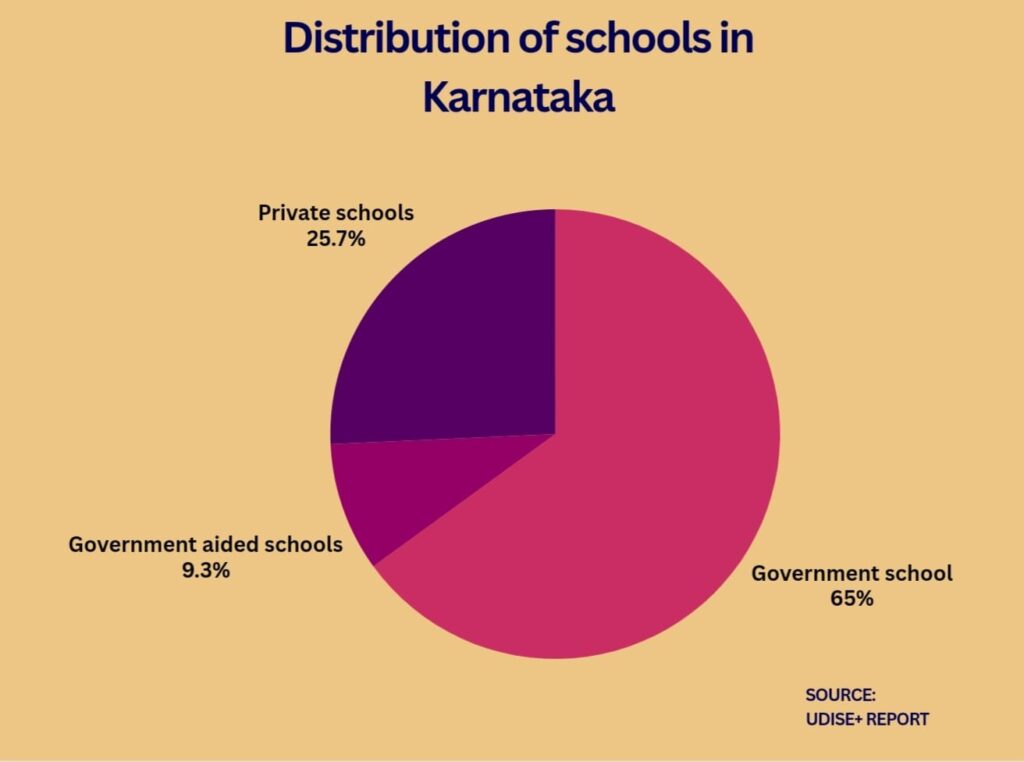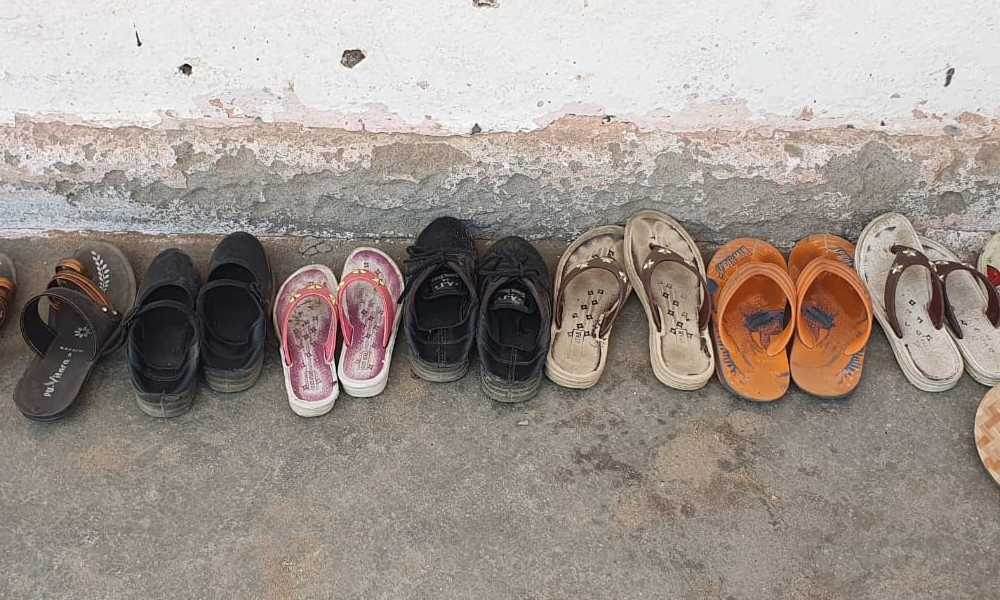Schools in Taluk are facing difficulties in various aspects to survive in this digital age. Teachers fear that they are not able to produce a digitally advanced generation.
It was a bleak surrounding, grey walls with plaster falling off them. It was dark in there. The only light that was intruding was from the windows with shattered glasses. Chattering voices filled the room, all looking in one direction. In front of them was a half-painted black wall. A perfect example of a modern India’s digital classroom.

No school in Gangavathi taluk of Karnataka has a digital classroom, smart board facility, or computers for students to learn. A few schools have a computer but it sits in the headmaster’s office covered with a cloth, far from a student’s touch.
Abdul Rasal, a ninth-grade student from Government High School Gangavathi, loves to see grown-ups working on computers. He said that there is only one smartphone in his family of 12 people. His uncle owns that smartphone. “Sometimes I take it to watch videos or movies. I see in those movies people working on computers in big cities. But I have never seen a computer physically. I highly doubt I will ever see it or work on it, as I do not know how it works, Rasal said.”
Digitization has blurred the divisive lines between the poor and the privileged said Prime Minister, Narendra Modi in 2022 while talking about the budget for the crucial education sector. But in reality, the lines have become more visible. Rasal has never experienced the internet apart from a few times on his uncle’s smartphone. He does not know what exactly the internet is and how it functions.
Kavita, a Kannada teacher in Rasal’s school said that they do not have an internet facility. “There is no use of the internet here. Even if the internet was available, where are we supposed to use it? We do not have any smart classes or computers. We teach in a very old-fashioned way. I sometimes think about the children’s future in government schools here. Private school students are moving way ahead of our school students. As private schools are modifying their facilities by the time but government schools are still lagging.”
According to the data provided by the Block Education Office (BEO), Gangavathi, there are 350 schools in the taluk comprising of government schools, aided and un-aided schools. But the government statistic shows 550 schools.
There are around 49,012 boys and 45,788 girls who are enrolled in these schools. Out of them, only one Government school in Gangavathi has a smart class. That school was renovated under the Prime Minister Schools for Rising India (PM SHRI) Yojana last year.
The Prime Minister announced the scheme on Teacher’s Day, Sept 2022. According to the tweet by Prime Minister Modi, the PM SHRI schools will have a modern, transformational, and holistic method of imparting education.
According to the Department of School Education and Literacy, Government of India, Under the scheme, there is provision for setting up more than 14500 PM SHRI Schools, two schools from each taluk. But schools in Gangavathi are applying constantly for the scheme, and they hardly receive any revert back, informed BEO.
“We want smart classes for students, we need computers in this day and age. This scheme is for overall re-development of the school that is why we keep on applying to the PM SHRI scheme every few months,” said Shreedhar, an English teacher at Government School in Gangavathi.
The idea of providing computer facilities in schools in Karnataka is not new. The Technical Assistance Learning Program (TALP), seeks to promote computer education in government schools and was started in 2016-2017 for five years. According to a study done by the Karnataka Evaluation Authority (KEA), the teachers have not been provided with the required facilities to implement the scheme. Anand, the education coordinator at the BEO office, in Gangavathi, informed that no schools in Gangavathi were considered under TALP.

Vaishnavi, an English teacher at Mehboob Nagar, Government school said that basic computer knowledge is the need of today’s age. “Today people are dealing with advanced technologies such as Artificial Intelligence (AI), whereas in India these poor kids have not even encountered computers at the school level. How will the country be dependent on the next generation where the students lack basic internet skills?,” she said.
A study was carried out by the Central Institute of Education Technology (National Council of Education and Research) on the Information and Communication Technology (ICT) @ schools scheme. The ICT scheme was revised under its eighth plan in 1998 to increase the accessibility of computers in schools and colleges. It also recognized the need for ICT in educational institutions.
The study shows that only 33 per cent of children in Karnataka report the skill of operating computers. 51 per cent of teachers are not trained under ITC in any way.
Under the ICT all schools in Karnataka were meant to be provided with internet facilities. It was reported by the government that 65 per cent of schools have an internet facility. However, the study found that only 19 schools were provided with internet facilities.
“We have not received any computers or internet facility under the ICT@ Schools Scheme. We do not conduct regular computer training for teachers. To maintain a computer lab it will cost around one lakh per school in maintenance. We are not provided with such kind of budget,” informed Anand.

There are organizations such as Wipro which are dedicated to providing quality education in schools all over India. The assistant manager at Wipro Technologies, Bangalore informed that Wipro is not dedicated to just providing computers to government schools but it works for total modification of schools with a holistic approach that includes training teachers, improving infrastructure, etc.
In 2013, the Azim Premji Foundation which comes under Wipro started an initiative to set up one school in every district to provide quality education or explore the possibility of managing government-owned schools.
In April 2019, Wipro (Azim Premji Foundation) collaborated with the Government of Karnataka, to improve the infrastructure and learning environment at VV Puram and MR Nagar schools in Bangalore Urban South district.
Prakash Chandra R, retired principal at Kendra Vidyalaya Sangathan and an education expert said,“When it comes to renovating or uplifting government schools, the government prefers to do work where it is visible to the public for example in major cities’ government schools. Even Wipro’s initiative was for schools in Bangalore. Therefore, schools at the taluk level are often neglected, or hardly benefits are enjoyed by only one to two schools in the taluk,” he said.
A report shows that the introduction of digital facilities in a classroom improved the enrolment and attendance percentage of students in school. But in Gangavathi it is next to impossible. Shreedhar, an English teacherat Government School, Gangavathi said that it is very hard to get students to class and teach them.
“Students come from a very poor background in our schools. Sometimes they juggle their life between coming to school and earning. Most of the time we educate their parents about how important education is for their children. Our hands are also tied as we are not able to provide quality education to kids. With smart classes, teaching sessions can be more creative and interactive. Students like to see creativity in teaching. We somehow manage to teach them the basic curriculum,” he said.
The Centre for Monitoring Indian Economy (CMIE) report shows that 86 per centof India’s labor force comprises those with education till 12th or below. The major workforce in India carries their livelihood on the skills learned from schools.
Pawan a high school student from, Government school, Gangavathi has never used the internet in his life. He said that he stopped going to school even after the pandemic was over. “I joined my father in labor work to make ends meet at the house. I just joined the school again this year. If I hadn’t missed these years I would have completed school till now. I do not have the internet at the house. I do not know how to use computers. Most probably I will start working at a rice mill after completion of school,” he said.
Umesh Prajapati, headmaster of Kendra Vidyalaya, Gangavathi thinks that the kids whose parents have money, enroll their kids in private schools. “Private schools provide computer facilities, smart classes, and internet facilities. It was possible before that a student from a government school could compete with a private school student as all education was on paper back then. But now even if a student scores well in boards and passes out of school with a good percentage, he will not survive in the work environment outside as it is all digital in big cities. Government should think about making drastic changes in terms of technology in schools,” she said.

In Karnataka, there are 47,449 government schools with 42,66,645 students enrolled. As of 2023-2024, the number of students going to private schoolshas increased in Karnataka to 46,43,225 from 45,13,902. But not everyone can afford private schools.
Veeresh parent of a girl student at Government High School in Gangavathi works at a rice mill. He earns Rs 200- 600 per day, depending on the work and season. “I also have dreams that my daughter become independent. That is why I encourage her to go to school every day. I know the school lacks many basic facilities. But I can not afford the fee of a private school.”
There are some other factors involved that are hampering the education in the taluk.
Less enrolment of students
Sumangala, the education coordinator at the BEO office informed that the enrolment of students in the government schools is falling. Karnataka has reported 567 government schools shutting down due to poor enrolment. There were 48,066 government schools in Karnataka, which decreased to 47,499 in 2022-2023
Manjunath, an English teacher said, “We collect the money from various school teachers and organize an event to advertise the importance of school education. This time the event is going to take place next week. Nobody pays us to conduct the event. We raise money from our own pockets, just for just for our children.”
He said that students who come here to study are from a very poor background and backward communities. They want to earn money as they think that this education will not help them in any way in the future.
No toilets, No desks, no infrastructure
There are no boys’ toilets in some schools. Boys have to run to their houses at lunch break to use the toilet and come back to study. The schools which have toilets are in very poor condition.
Moreover, in some schools, there are no desks or chairs to sit on. Some schools are more than 80 years old therefore the infrastructure is also 80 years old. Since the school was built there has been no renovation done informed the headmaster of a government school.
“This year we have received Rs 45 lakhs for the renovation of toilets before we used to get just Rs 25 lakhs for the renovation of toilets in the government schools of all the taluk. We have asked for at least Rs 55 lakhs next time,” said Shiv Kumar, BEO Office Manager.

Experts believe that denying government school students access to computers and digital classrooms not only hinders their ability to compete in a technology-driven world but also brings a sense of inequality.
Prakash Chandra R explains that India stands at a critical juncture where technological advancements are reshaping industries and economies worldwide. However, the digital divide in education, especially in government schools, remains a matter of concern. The lack of computers or digital classrooms not only limits student’s access to information but also deprives them of the digital skills needed for the future workforce.
He further added, “Look at the condition of government schools in Delhi now.The Delhi government has done a great job in uplifting government schools. They trained the teachers, renovated the buildings, provided a good amount of budget for schools, etc. We as teachers hope that someday our government will also focus more on building a better education system.”
Meanwhile, students like Rasal and Pawan will keep studying from that painted black wall in school, considering for future that they might join their fathers working in rice mills or labor work after completing their education at school.




